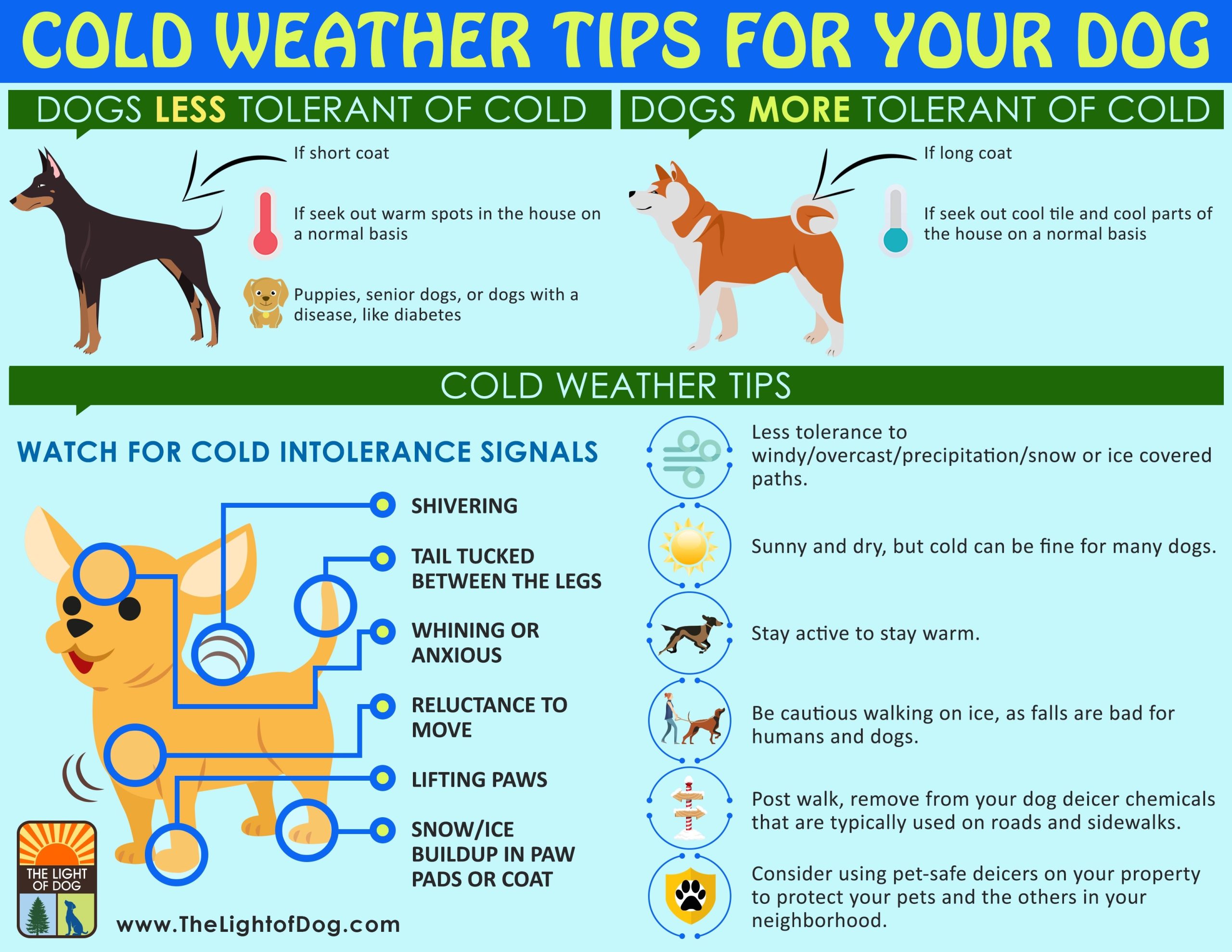Walking a dog in below 20°F or -6°C is too cold and unsafe. Walking a dog in extremely cold temperatures can lead to hypothermia, frostbite, and other health issues.
As pet owners, we love to take our furry friends for a walk or outdoor activities, but when temperatures drop, it’s crucial to ensure your dog’s safety. Winter can be brutal, and the cold can adversely affect your dog’s health.
Not only can it cause hypothermia and frostbite, but it can also aggravate certain health conditions like arthritis and respiratory problems. Pet owners should know the warning signs when it’s too cold to take their dogs outside, ensuring their well-being. We will discuss the factors to consider when determining if it’s too cold to walk your dog and how to keep them safe during winter.

Credit: www.bellaandduke.com
The Science of Cold
How Dogs Lose Heat
Dogs regulate their body temperature differently than humans. They lose heat primarily through their paws, ears, and by panting. Unlike humans, their skin plays a minor role in thermoregulation, which makes them more susceptible to cold ground surfaces and chilling winds.
Signs of Hypothermia and Frostbite in Dogs
Hypothermia in dogs can occur when they’re exposed to cold temperatures for too long, causing their body temperature to fall below normal levels. Symptoms include shivering, lethargy, and weak pulse. Frostbite, though less common, can affect ears, paws, and tails, leading to pale or blue-tinged skin that’s cold to the touch.
Temperature Thresholds for Dog Walks
General Guidelines for Safe Temperatures
As a general rule, temperatures below 32°F (0°C) can be dangerous for most dogs, especially if they are small, thin-coated, elderly, or have health conditions. Breeds with thick coats may tolerate colder weather but should not be exposed to freezing temperatures for prolonged periods.
Adjusting for Wind Chill and Humidity
Wind chill can make temperatures feel much colder and pose a risk to your dog’s well-being. Humidity, or the lack thereof, can also affect how cold temperatures impact your dog. Always consider the wind chill factor and humidity levels before deciding to take your dog out for a walk in cold weather.
Pre-Walk Preparation
Assessing the Weather: What to Look For
Check the temperature, wind chill, and humidity levels before heading out. A quick weather check can help you determine whether it’s safe for a walk or if you need to make adjustments to keep your dog warm.
Dressing Your Dog for the Cold: Tips and Product Recommendations
Dogs with short coats or low body fat may benefit from wearing a sweater or jacket. Look for waterproof and insulated options to provide warmth without restricting movement. Products should fit well, covering the belly and extending towards the tail but not hindering natural movement.
The Importance of Paw Protection: Balms and Booties
Protecting your dog’s paws is crucial in cold weather. Use paw balms to prevent cracking and booties to protect from cold surfaces, salt, and chemical deicers. Ensure booties fit snugly and check regularly to ensure they’re comfortable and not causing irritation.
During the Walk
Monitoring Your Dog’s Behavior and Physical Signs
Pay close attention to how your dog is acting. If they start to shiver, hold up their paws, or show reluctance to keep moving, it’s time to head back. These signs indicate discomfort or the beginning stages of cold-related stress.
Keeping the Walk Enjoyable and Safe in the Cold
Keep walks short and stick to paths that have been cleared of snow and ice. Engage in light play or training exercises to keep blood flowing without causing your dog to sweat, as dampness increases the risk of hypothermia.
Emergency Signs: When to Cut the Walk Short
Immediate signs of distress, such as limping, whining, or any sign of hypothermia or frostbite, mean you should immediately end the walk and seek shelter. If symptoms persist, consult your veterinarian as soon as possible.

Credit: www.mspca.org
Post-Walk Care
Warming Up After a Cold Walk: Best Practices
After returning from a chilly excursion, it’s crucial to help your dog warm up properly. Gently drying your dog with a towel, especially their paws and belly, removes any snow, ice, or salt they may have encountered. Providing a cozy, warm bed away from drafts allows them to comfortably raise their body temperature.
Checking for Cold-Related Injuries
Cold weather can cause frostbite and irritate paw pads. Post-walk, examine your dog’s paws for cracks, bleeding, or signs of frostbite, such as pale, hard skin. Check their ears, tail, and nose as well. If you notice any worrying signs, contact your veterinarian promptly.
Hydration and Nutrition in Winter Months
Staying hydrated is just as important in winter as in summer. Ensure your dog has access to fresh, unfrozen water. Dogs may require more calories in the cold months to help maintain their energy levels and body heat, so consult your vet about potentially adjusting their diet.
Special Considerations
Puppies and Senior Dogs: Extra Precautions
Puppies and senior dogs are more vulnerable to the cold. Limit their exposure to cold weather and opt for shorter, more frequent walks. Consider extra layers for warmth, like sweaters or coats, and always monitor them for signs of discomfort or distress.
Health Conditions That Worsen in the Cold
Certain health conditions, such as arthritis, can worsen in cold weather, leading to discomfort or pain for your dog. For pets with pre-existing conditions, it’s vital to consult with your vet to devise a winter care plan that may include medication adjustments or specific exercises.
Short-haired vs. Long-haired Breeds: Different Needs
Short-haired breeds lose body heat more easily, making them more susceptible to the cold. They might benefit from wearing insulated coats or sweaters. Conversely, long-haired breeds are naturally better insulated but may require more grooming to prevent wet fur from causing a chill.
Alternatives to Outdoor Walks
Indoor Exercise Options for Cold Days
When it’s too cold for outdoor activities, keeping your dog active indoors is essential for their physical and mental well-being. Interactive toys, such as treat-dispensing puzzles, can keep them engaged, while indoor fetch and tug-of-war games help maintain their fitness levels.
Engaging Your Dog Mentally When Outdoor Activities Are Limited
Mental stimulation is as crucial as physical exercise. Teach your dog new tricks or commands to keep their mind sharp. Setting up obstacle courses or hide-and-seek games with treats can also provide fun and engaging ways to stay active indoors.
Frequently Asked Questions For What Temperature Is Too Cold To Walk A Dog
How Cold Is Too Cold To Take A Dog For A Walk?
The temperature that is too cold to take a dog for a walk depends on various factors, such as the pet’s hair coat, activity level, and health condition. However, there are some guidelines to follow, and it is generally advised not to walk dogs outside if the temperature drops below 20°F (-6°C).
How Cold Is Too Cold For Dogs Paws?
Dogs’ tolerance for cold varies, but generally, paws are vulnerable to frostbite below 32°F (0°C). Limit walks to 20 minutes or less in temperatures below 20°F (-6. 7°C) to avoid health risks. Keep an eye on your dog and look for signs of frostbite or discomfort.
What’s The Lowest Temperature A Dog Can Be Outside?
The lowest temperature a dog can be outside depends on various factors such as the pet’s hair coat, activity level and overall health condition. However, as a general guideline, it is too cold to take a dog out for a walk if the temperature drops below 20°F (-6°C).
Is 43 Degrees Too Cold For A Dog?
Yes, 43 degrees is too cold for a dog to be outside for an extended period. Factors like the dog’s condition, hair coat, and activity level can influence at what temperature a dog can be outside. As a general guideline, pet owners should avoid walking their dogs when temperatures drop below 30 degrees Fahrenheit.
Conclusion
Knowing the appropriate temperature to walk your dog is crucial to ensure their safety and well-being. Factors such as breed, age, and health condition are essential to consider before taking your dog out for a walk. As a responsible pet owner, you must be mindful of their behavior and observe any signs of discomfort.
Your dog’s comfort and safety should always come first, even if it means skipping a walk during extreme weather conditions. Remember, it’s better to be safe than sorry when it comes to your furry friend’s health.





One Response